
Photo of Dr. Bob Jones, Jr. with symposium speakers from 1965 grand re-opening of the museum in front of the 15th-century painting by Antonio Checchi, called Guidaccio da Imola in gallery 1.
Below the image, click play to listen.
In Part 2 (of 2 segments), Dr. Rhonda Galloway continues by introducing Robert Browning and highlighting how his courtship with Elizabeth began–a courtship that grew into a celebrated love story and a happy marriage.
Go back to Part 1 HERE.
Glazed earthenware, signed G. Battaglia
Italian, c. 1826-1887
Majolica is earthenware that has been fired in a kiln, coated with an opaque white glaze, decorated with other pigments and fired again, fixing the glaze and design onto the ceramic. The process originated in Africa around the 6th century. By the 13th century, techniques and the ability to paint detailed designs were perfected. It was discovered that a clear glaze and a third firing added luster to the piece.
Italians became enamored of these decorative ceramics. Large quantities were produced in Africa and Spain and passed through ports on the Spanish island of Majorca on their way to Italy. Thinking the pieces had been made there, Italians called this kind of ceramic majolica or maiolica.
By the Italian Renaissance, techniques for producing majolica ceramics had reached Italy. Ceramists produced decorated plates, jars, cups, pitchers, and ornamental pieces. Often the item featured a portrait of a bride, a family member or some notable. Apothecary jars bearing the name of their contents were embellished with scrolling vines, leaves, flowers, and fruits. Wealthy families would display large sets of dishes and serving pieces which were used to impress guests at elaborate banquets.
Often these pieces were istoriato, meaning they illustrated a story—usually mythological, historic, or biblical. Sometimes the narrative would cover the entire surface of the piece; other times, as seen on M&G’s charger, the picture would be surrounded by intricately designed borders. Today museums and collectors prize even the broken pieces of Italian Renaissance majolica.
Although it may look it, M&G’s Majolica Charger is not dated to the Italian Renaissance. In the late 1800s, there was a resurgence of interest in the Italian Renaissance ceramic design, and Italian ceramists produced high quality stoneware in the Renaissance style to meet the demand. M&G’s charger is one such piece.
Making Majolica
Creating an elaborate majolica requires great skill. Not only must the clay be formed and fired carefully, but the tin oxide glaze which dries into an opaque, white surface must also be evenly applied. Colored glazes are then painted onto the prepared surface. The color palette is extremely limited. Black, yellow, blue, golden brown, and green were used on M&G’s charger—typical of majolica designs. Diluting, concentrating, or mixing the glaze pigments can produce various shades of colors.
Painting on the porous white surface is extremely unforgiving. Once applied, the pigment cannot be removed or hidden by painting over it. Adding pigment to the initial layer produces different effects; however, the original brush stroke, as well as any additional painted strokes and colors in subsequent layers must be adeptly applied. There is no way to repair a mistake.

Consider the border on the lip of M&G’s charger. The inner ring consists of an amber background with 50 hand-drawn, double circles of two different intensities of a golden-brown pigment. The outer border contains 8 fauns, 4 winged angel heads, and 4 angel torsos arranged among scrolling foliage and architectural flourishes. These are arranged in four matching quadrants. The figures are outlined in black and shaded with gray. After the black outlines were painted, the intense blue background areas were painted individually. The lip alone required a precise, highly skilled artisan.
Gaetano Battaglia
Painters of istoriato majolica scenes were consummate craftsmen, such as Gaetano Battaglia (c. 1826-1887). During his lifetime he was known as “a painter of figures.” His exquisite work, often large ceramics with Battaglia’s signature, are in museums and private collections.
His career started around 1850 in Naples, Italy, but little is known of his early works or employment. When the Mosca brothers founded Raffaele Mosca & Compagno in 1865, they hired Battaglia, and he helped them hire other ceramic painters. During the company’s more than 40-year history, its name and ownership repeatedly changed. Mosca produced architectural ceramics and decorative pieces, and it was known for producing an “odorless toilet,” patented by one of the brothers. Battaglia’s duration at the firm, however, is unknown.
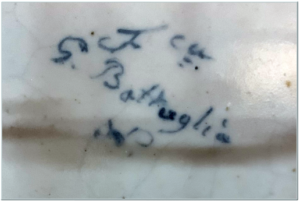 Most ceramic painters of the period did not (or were not permitted to) sign their pieces. While many works are attributed to Battaglia, most earthenware known to be his are inscribed with his signature or initials. Generally, his signature is paired with the letter “N” or with “Napoli” for Naples. M&G’s Majolica Charger bears both Battaglia’s signature and an “N” on the reverse.
Most ceramic painters of the period did not (or were not permitted to) sign their pieces. While many works are attributed to Battaglia, most earthenware known to be his are inscribed with his signature or initials. Generally, his signature is paired with the letter “N” or with “Napoli” for Naples. M&G’s Majolica Charger bears both Battaglia’s signature and an “N” on the reverse.
The specific company that produced many of Battaglia’s signed pieces, however, is unknown. The “Fca” on M&G’s charger (which appears as “Fabb” on other Battaglia pieces) presumably stands for Fabbrica, Italian for “factory.” At that time there were numerous ceramic companies in Naples which had Fabbrica as part of their name. Battaglia may have worked for one of those companies or fired his earthenware designs in a hired kiln, which was a known practice at the time.
The Image
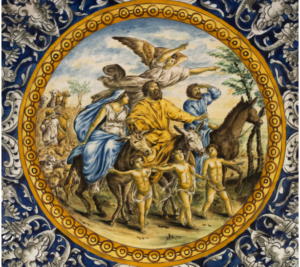 For istoriato earthenware, ceramists in the 1800s often referenced narrative etchings as their design source. The artists would also sketch scenes found in galleries, churches, and palaces as inspiration for their works. A popular image would often be painted by different ceramists on various earthenware pieces, but the source of the design can help identify the narrative’s subject.
For istoriato earthenware, ceramists in the 1800s often referenced narrative etchings as their design source. The artists would also sketch scenes found in galleries, churches, and palaces as inspiration for their works. A popular image would often be painted by different ceramists on various earthenware pieces, but the source of the design can help identify the narrative’s subject.
M&G’s Charger appears to be unique in that the source of the narrative image is unknown, and no other ceramics are known to have a similar subject. Therefore, only details in the image can be used to determine the pictorial scene. The flowing, loose-fitting garments on the three main figures are of the type artists of the time used for Biblical characters. The winged angel pointing a direction and the three putto leading the procession further suggest a Biblical illustration.
For many years, Flight of the Holy Family into Egypt was the title associated with the charger; however Mary, Joseph, and the infant Jesus were the only Biblical characters involved in the secretive escape from Herod’s slaughter of the innocents (Matthew 2:13-21). The missing infant Jesus and the second adult male on M&G’s charger make this assumption unlikely. Also, the angel instructing Joseph to take his family to Egypt appeared to him in a dream prior to the journey and is rarely included in paintings of the subject by the Old Masters. Additionally, the Holy Family was of modest means and traveled discreetly; yet the charger depicts a large entourage of people and animals behind the three mounted figures. Neither does the imagery follow typical illustrations of the family’s return from Egypt.
More likely the scene is Abraham, his wife Sarah, and nephew Lot on their departure to Canaan. God directed Abraham to travel “unto a land that I will shew thee.” A pointing angel and the procession of putto are used as an artistic rendering of God’s directing the travelers. The 75-year-old Abraham, his “fair. . . to look upon” wife, and the younger Lot correspond to the mounted figures on the charger. Their servants, belongings, and herds are depicted following the main figures (Genesis 12).
While a great deal is known about M&G’s charger, many questions remain unanswered. Was this rarely depicted scene part of a set of dishes and serving pieces illustrating various biblical scenes? If so, do other pieces of the set exist? Or was this piece a unique, limited commission for a specific purpose? More research may reveal answers, but some specifics may never be known, which only adds interest to M&G’s mysterious, beautiful Majolica Charger.
William Pinkston, retired educator and M&G volunteer
Published 2021
Suggested References:
Walnut
16th century, Italian
When one thinks of prayer, furniture is not usually the first thing to come to mind. In Matthew 6:5-6, Christ encouraged making requests in prayer privately, rather than praying to be noticed publicly. However, a common piece of furniture constructed for the purpose of prayer was manufactured during the Renaissance and is still being made today. It is known as a prie-dieu, derived from French for “praying to God.” This special furnishing serves the same purpose as a prayer desk and a prayer chair.
M&G currently has two prie-dieux in its collection. These may have been used in a church, cathedral, or even a home. As a common piece of liturgical furniture in the Roman Catholic Church, they are still in use for worship, weddings, and funerals. When President Kennedy was lying in state, prie-dieux were in the same room.
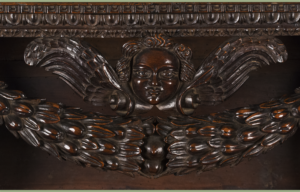 Both of M&G’s Prie Dieux are from Italy, dating to the early Renaissance in the late 15th to mid-16th centuries. Ornately carved walnut adds to the richness of their finish. One has a hinged kneeler with a raised panel door in the middle and a small drawer at the top. The other’s “lectern top” sits on “two powerful scroll consoles edged with gouge carving in a scale effect; the base terminates in small posts with pine-cone finials.” However, “the most striking feature is the festoon suspended from the top” with “fruit-and-leaf forms enclosing a winged angel head.”
Both of M&G’s Prie Dieux are from Italy, dating to the early Renaissance in the late 15th to mid-16th centuries. Ornately carved walnut adds to the richness of their finish. One has a hinged kneeler with a raised panel door in the middle and a small drawer at the top. The other’s “lectern top” sits on “two powerful scroll consoles edged with gouge carving in a scale effect; the base terminates in small posts with pine-cone finials.” However, “the most striking feature is the festoon suspended from the top” with “fruit-and-leaf forms enclosing a winged angel head.”
Additionally, two paintings in M&G’s collection include prie-dieux. Both pictures highlight the importance of the Annunciation. The archangel Gabriel came to Mary to inform her that she had found grace in the sight of God. She would be privileged to bear the long-awaited Messiah, Jesus Christ. Christ Himself would become the only means of access to God the Father—through prayer. As explained in I Timothy 2:5-6, this direct access was accomplished through His passion and resurrection, which is symbolized by an open door on the prie-dieu. Fellowship with God in heaven is available to all people.
St. Gabriel the Archangel and The Virgin Annunciate by Venetian Reniassance painter, Francesco Montemezzano, were formerly one complete canvas (with one other M&G painting of God the Father depicted with a group of angels). These works were separated into three sections, which are all in M&G’s collection. The artist depicts Mary kneeling at her prie-dieu as she converses with Gabriel, who is seen on the opposite canvas.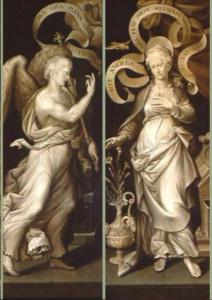
The Altar Wings with Scenes from the Birth of Christ was created by an unknown Netherlandish artist. These wood panel paintings were completed during the same century as the Montemezzano canvases—roughly mid to late 1500s. Once the hinged doors of a larger altarpiece, these special panels hid the interior artistic scenes, which would be opened for special services or events. The interior paintings were in vivid color; however, the exterior doors like these were usually painted in gray tones, known as grisaille. This technique suggested a sculptural effect. Gabriel the archangel is positioned on the left panel facing Mary on the right. Mary is depicted with a lily (symbolic of her purity and Christ’s future resurrection) and a prie-dieu (on the far-right edge).
Prie-dieux are found in museum collections around the world—both as furniture and within the pictorial settings of Old Master paintings. London’s Victoria and Albert Museum has a prie-dieu closely resembling one of M&G’s. The National Gallery’s Venetian Annunciation depicts Mary sitting at a prie-dieu.
Prayer is more often discussed than practiced. Fortunately, the opportunity exists for not only God’s children to approach their Heavenly Father, but anyone seeking His help—with or without a prie-dieu.
John Good, Security Manager
Published 2021
Further Resources:
Aronson, Joseph, Furniture in the Bob Jones University Collection
Hiebert, D. Edmond, Working With God Through Prayer
Oil on canvas
Venetian, 1696–1770
One of the latest Italian painters represented in the Museum & Gallery Collection is the greatest artist of 18th-century Venice, Giambattista Tiepolo. While Tiepolo achieved most of his fame through breathtakingly airy frescoes on the ceilings of palaces, churches, and villas, he also revived age-old themes from the Bible and antiquity through fresh interpretations. Such is the case with a series of bust-length portraits of bearded old men, begun perhaps as early as the 1740s. These men in oriental garb are widely regarded as a series of ancient philosophers, but no definite case may be made for the group since most lack traditional attributes. Tiepolo was certainly influenced by Rembrandt’s paintings of bearded old men which may also be perceived as simple character studies.
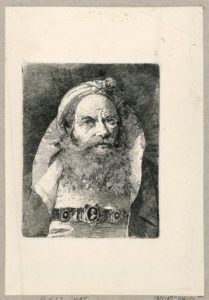 The present painting is the original treatment by Tiepolo that together with others from the series was later copied by his artist sons, Domenico and Lorenzo, in etchings called La Raccolta de Teste (The Collection of Heads). The vigorous brushwork, vibrant colors, elaborate dress, and penetrating gaze of the sitter combine to make M&G’s Philosopher Holding a Book an excellent example of Tiepolo’s lesser-known skills at small-scale work. The etching to the left is made by Giovanni’s son as a copy of his father’s work. These smaller versions usually omit the hands, but the cloak clasp is included.
The present painting is the original treatment by Tiepolo that together with others from the series was later copied by his artist sons, Domenico and Lorenzo, in etchings called La Raccolta de Teste (The Collection of Heads). The vigorous brushwork, vibrant colors, elaborate dress, and penetrating gaze of the sitter combine to make M&G’s Philosopher Holding a Book an excellent example of Tiepolo’s lesser-known skills at small-scale work. The etching to the left is made by Giovanni’s son as a copy of his father’s work. These smaller versions usually omit the hands, but the cloak clasp is included.
One of the virtues of art that John Keats extols in his poem “Ode on a Grecian Urn” is the ability of art to ask questions of the viewer. Sometimes these questions are answerable; sometimes they aren’t. But the mystery is what draws viewers to return, allowing them to absorb more of the work as well as more of the mystery.
So, what is it that makes this seemingly straightforward portrait of a man with a book so interesting and intriguing?
All of these questions can be frustrating to art historians and viewers alike. But Keats would propose that they are an indication of good art, something beautiful that attracts further examination, pondering, and appreciation without final satisfaction. Good art pulls us out of ourselves and reminds us, like Horatio, that “there are more things in heaven and earth. . . than are dreamt of in your philosophy.” Doubtless, this philosopher with a book would have agreed.
Dr. Karen Rowe Jones, M&G board member
Published 2021
At the dawn of the 16th century Mannerism was gaining in popularity. Even noted Renaissance painters like Raphael began to mirror the style, but it was the Sienese painter Giovanni Antonio Bazzi who would push the mannerist vision even further.
Oil on canvas
16th or 17th century
This beautiful 16th or 17th century work by an unknown Italian artist stands out due to its rectangular shape spanning approximately 9 ½ feet long. The artist used the entire length of the painting to masterfully demonstrate his knowledge of architecture and perspective. He also illustrates Palladian-style architecture which was inspired by Ancient Greek and Roman temples and focused on symmetry and proportion based on mathematical principles. The massive Corinthian columns, Roman-style sculptures in the niches along the arcade, and decorative motifs above each of the many doorways further exemplify the Palladian character of the structure. The painting also demonstrates the realistic use of lighting and perfect proportion of the figures (clad with a variety of rich, vibrant color) in comparison with the enormous temple-like structure. The actual site of the Pool of Bethesda, the subject of this painting, was discovered in the late 19th century confirming its description in the Gospel of John.
The artist captures one of only two miracles Jesus performed in Jerusalem. For those living in this part of the world, water was vital to all aspects of life. The Pool of Bethesda was no exception. The pool was divided into two reservoirs with one most likely functioning as a ritual bath (mikveh) and the other used to replenish it. Many sick, lame, and blind came to the pool because of the pool’s supposed healing powers, a long held pagan tradition. They believed that an angel would come and stir the waters and whoever stepped into the water first would be healed of his ailment (John 5:3-4).
Jesus knew there would be large crowds attending a religious festival in Jerusalem (John 5:1) and therefore, witnesses to what he was about to do. To the right of the painting, Jesus, wearing a dark blue cloak, and accompanied by a few of his disciples, approaches one of the many invalids. Jesus specifically chose a crippled man who had been ill for 38 years. Jesus asks him, “wilt thou be made whole?” (John 5:6) The invalid tells Jesus that he has no one to help him into the water and that he can never get to the water before someone steps in before him. Jesus does not lay hands on the man or touch him in any way but instead commands the invalid to get up, pick up his bed and walk. Miraculously, the man is completely healed by only words of Jesus.
The miracle of the lame man’s physical restoration revels Jesus’s identity as the Jewish people’s long-awaited Messiah. Instead, the Jewish leaders remained spiritually blind focusing only on the fact that Jesus healed a man on the sabbath which violated their oral traditions expanded from the Law of Moses. Jesus later finds the healed man in the temple and in addition to physical healing offers spiritual healing encouraging the man to “sin no more” (John 5:14). This miracle not only showcases Christ’s compassion for those enduring physical afflictions but also, and more importantly, reveals His desire to provide spiritual healing for all from the ravages of sin.
Rebekah Cobb, Registrar
Published 2021